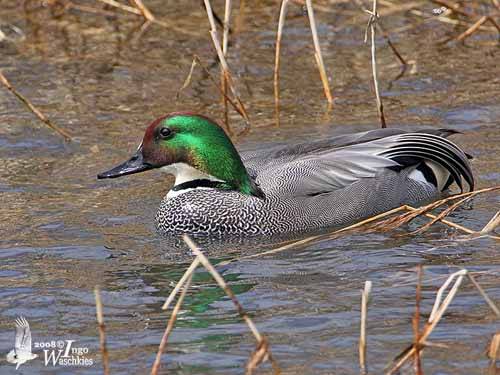
Fr: Canard à faucilles
All: Sichelente
Esp: Cerceta de Alfanjes
Ital: Anatra falcata
Nd: Bronskopeend
Sd: Praktand
Photographers:
John Anderson
John Anderson Photo Galleries
Aurélien Audevard
OUESSANT DIGISCOPING
Tom Grey
Tom Grey's Bird Pictures
Ingo Waschkies
Bird Photography
Text by Nicole Bouglouan
Sources:
HANDBOOK OF THE BIRDS OF THE WORLD vol 1 by Josep del Hoyo-Andrew Elliot-Jordi Sargatal - Lynx Edicions - ISBN: 8487334105
GUIDE DES CANARDS, DES OIES ET DES CYGNES – de Steve Madge - Delachaux et Niestlé - ISBN: 2603013769
BirdLife International (BirdLife International)
Bird Web (Seattle Audubon Society)
What Bird-The ultimate Bird Guide (Mitchell Waite)
Falcated Duck
Mareca falcata
Anseriforme Order – Anatidae Family
INTRODUCTION:
This beautiful Asian duck is the only one in the Anatidae family with sickle-shaped tertial feathers. This morphological feature gives the duck its name.
DESCRIPTION OF THE BIRD:
Biometrics:
Length: 46-54 cm
Weight: 422-770 g
The Falcated Duck adult male in breeding plumage has grey body plumage, with small black crescents on breast, and narrow, dark vermiculations on mantle, body sides and flanks. Belly and vent are yellowish-white, with black-and-white pattern.
The elongated scapulars are pale grey, whereas the long tertials are sickle-shaped and hanging off the back. Secondaries are glossy green, forming a conspicuous mirror on the open wings. Primaries are blackish-grey. The underwing is paler, with white axillaries.
Rump, uppertail-coverts and tail are blackish. We can see a broad white subterminal band. Undertail-coverts are yellowish-white with black and white edges.

On the head, there is a long crest, extending down to the nape. The glossy plumage shows green, bronze and crimson iridescences, often very different according to the light. We can see a white spot on the forehead, at base of the upper mandible. Chin, throat and foreneck are white, barred by narrow black collar.
The slender bill is long and blackish. The eyes are dark brown. Legs and webbed feet are dark grey.
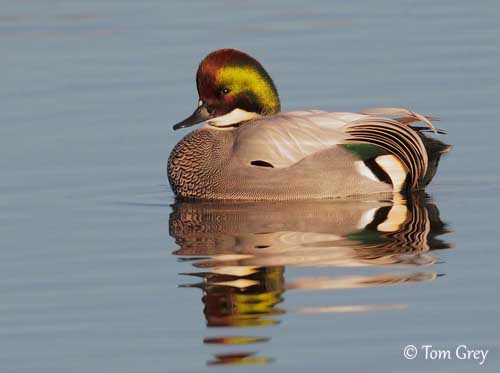
In non-breeding plumage, the male resembles female but it has darker head and upperparts, and shorter tertials.
The adult female has warm brown plumage with heavy brown and blackish pattern, formed by numerous dark crescents, involving cryptic effect. On the wings, the green mirror is duller and tertials are much shorter and straight.
On the head, the crest is shorter. Head and neck are greyish-brown with narrow darker streaks. The bill is dark grey with blackish spots on culmen. She is paler overall than the non-breeding male.
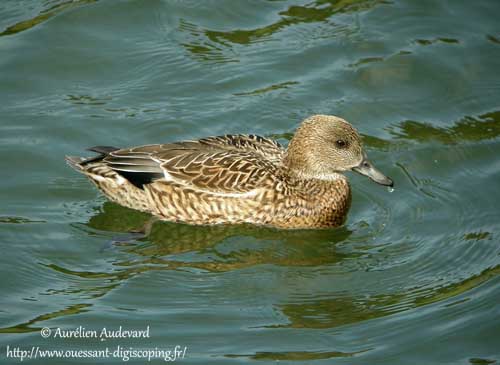
The juvenile resembles female with yellower plumage and shorter, curved tertials.
RANGE:
The Falcated Duck is found in SE Siberia and Mongolia, to Kuril Islands and N Japan.
This species is migratory and spends the winter in E Asia, China, Japan, Korea and Vietnam, and in other scattered regions W to NE India. Vagrants may occur further W and E.
HABITAT:
The Falcated Duck breeds usually on freshwater lakes, rivers, lagoons and ponds, in areas with scattered trees.
During winter, it can be found in coastal areas and shallow water bodies, plains with flooded meadows, and sometimes in estuaries.
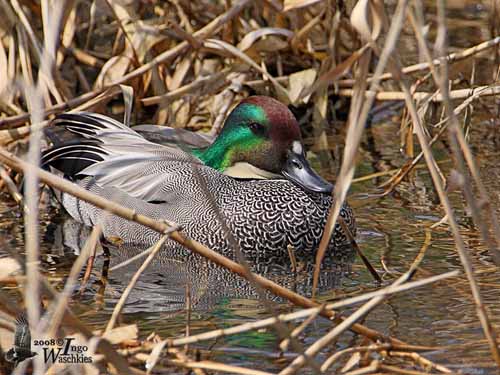
CALLS AND SONGS: SOUNDS BY XENO-CANTO
The Falcated Duck is usually silent outside the breeding season. The male utters clear, low-pitched whistle, followed by a trilled “oui trr”. The female has more raucous voice.
BEHAVIOUR IN THE WILD:
The Falcated Duck feeds mainly on plant matter including seeds, rice and grain, green parts of aquatic plants and grasses. Some aquatic invertebrates such as insects and molluscs can be taken too.
Like other Anatidae species, the Falcated Duck feeds by dabbling and upending in water. It also grazes on dry land. But it usually remains close to the emergent vegetation.

This species is often seen in pairs or in small groups. However, they form large flocks during the migrations.
Courtship displays are poorly known, but male’s ornaments such as long crest and elongated sickle-shaped tertials, are probably enhanced by adapted postures and movements.
The Falcated Duck has fast flight, and it is able to take off easily from water. The direct flight is performed with strong, steady wingbeats.
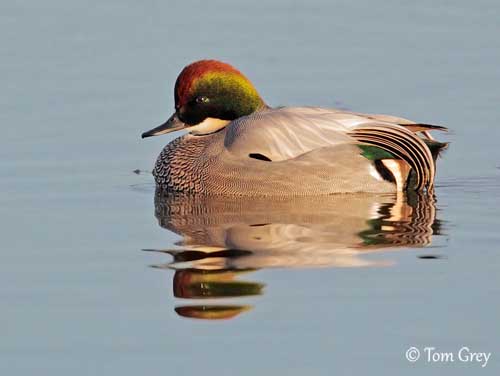
REPRODUCTION OF THIS SPECIES:
The breeding season starts in May/June. The Falcated Duck may breed in isolated pair or in small, loose group. This species is monogamous.
The nest is on the ground close to the water, and hidden in tall grasses or under bushes. It is made with grasses and lined with down.
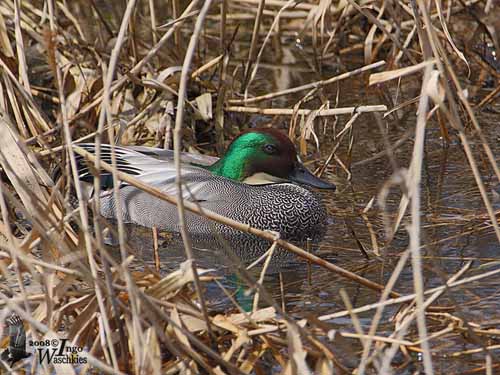
The female lays 6-9 creamy-white eggs, and incubates during 24-26 days. At hatching, the chicks are covered with dark brown down above and buff below. The male may assist the female during the incubation and the first days after hatching, when the chicks are very small. They follow the adults very soon after hatching.
The moult takes place in summer after the breeding season.
PROTECTION / THREATS / STATUS:
Following rapid decline of its populations in China, added to high hunting pressure, the Falcated Duck is evaluated as Near Threatened.
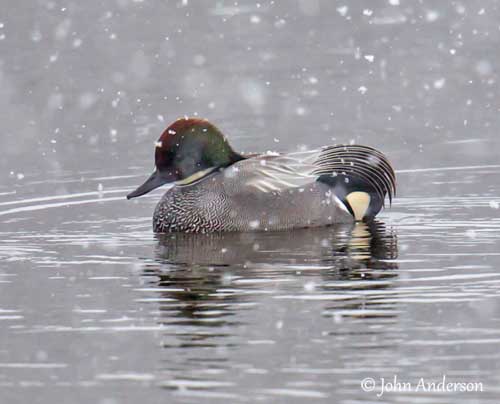
Head colours may appear very different according to the light. Here under the snow.